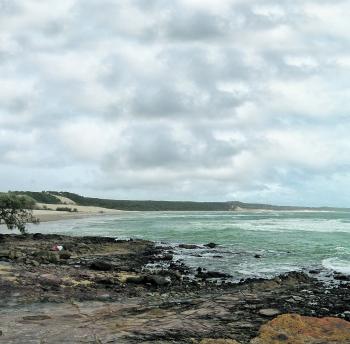It’s generally believed that tailor follow a northerly migration pattern from New South Wales then along the beaches of South Queensland, finally making it to Fraser Island. While this sounds feasible, I’m of the opinion that there are other factors coming into play that might at least modify the general northern migration theory.
During autumn and early winter, tailor feed ravenously on various baitfish species as they build up reproductive tissues in preparation for spawning. From vantage points along the island during early winter, they can be observed creating quite a rumpus as they upset bait balls of mostly pilchards and anchovies, not far out beyond the breakers.
Then as seasonal offshore winds settle the inshore waters down, tailor start following baitfish into calmer inshore waters. If a start to the Fraser Island tailor season needs to be defined, it would be when regular winds out of the west start to dominate.
It has been shown in scientific studies many years ago that the surf zones between Indian Head and Waddy Point are major tailor spawning areas. This is the reason why these waters have been closed to all fishing during August and September, to give the fish a chance to do their thing without disturbance.
This might be the case, however I would suspect that spawning areas extend well beyond this, possibly along most of the island’s east coast. Well-oxygenated waters and an abundance of food are needed by these spawning tailor.
Already there have been desirable breezes and a few reports of early season tailor filtering in. Most have been small fish. At least it’s a start. During this month we can expect the first of the bigger greenbacks to turn up in the inshore gutters. I don’t want to sound like a pessimist, but we need to remember the disaster that almost wiped out the tailor season last year.
I am referring to the masses of floating brown and red weed that moved into the inner waters from mid-July through to at least December in 2016. This year there have been a few periods when it has reappeared. During the Easter holiday period it was bad enough to make fishing difficult, but not impossible. I won’t mention weed again. It depresses me.
Once the season becomes established, tailor will be taken right along the eastern beach as far as Sandy Cape, as well as around the headlands when they aren’t closed during August and September. Although generally widespread, there are a few sections of beach that seem to be particularly reliable.
The first that comes to mind is between Cathedral Beach and Dundubara, a beach with plenty of well-defined gutters with deep entrances. As the waves break along the outer bank, white water spills over into the deeper gutter. Holes and spits can also involve breaking waves and white water, so these features should also be tested out.
This is a section of beach that is well endowed with suitable campsites. Tent cities are established here, particularly during the September school holidays. Excellent gutters that are comfortably fished by anglers of various skills add to its popularity. Many families come regularly each year to make their holidays great social events. Catching a few tailor would always be a bonus.
Further north the stretch of beach up to Indian Head regularly turns on some of the island’s best tailor fishing. Indian Head is well known for the quality of tailor taken there. Almost all fishing is done from its northern face where swells coming around the headland break over shallows to produce one huge feature of white water. From the beach the track out to your chosen fishing spot is not a walk in the park.
Good vantage points aren’t plentiful, so when the rocks become crowded with anglers, tempers can become just a little frayed. I prefer to fish the beach. From 400m south of Indian Head to 400m north of Waddy Point, fishing of any kind is not permitted from midday 1 August to midday 30 September. This includes the beaches between the two headlands as well as Middle Rocks. It should also be noted that Middle Rocks and its small included beaches are zoned green, so fishing is not permitted throughout the whole year in this area.
The northern face of Waddy Point also fishes well for tailor, when it’s allowed. Further north between Orchid Beach and Ngkala Rocks and further on to Sandy Cape, there is no shortage of great tailor country. I should point out here that negotiating the bypass track behind Ngkala Rocks can be difficult and it’s best left to the capable 4WDs and very capable and experienced drivers.
In my column in the July 2016 mag, I examined some of the history of recreational tailor fishing on Fraser Island. Not wishing to delve into that again this year, I might just point out again that there have been lots of changes over the last five decades or so.
Changes in the management of the fishery have seen the end of the bad old days when fishers were taking as much of the resource as they liked. Currently, with a legal minimum size of 35cm and a bag limit of 20, most recreational anglers are happy to comply, but also do so with their contribution to sustainability in mind.
Just as we have seen management requirements changing, so too have fishing methods and equipment. We will take a closer look at this next month and check out the progress of what we all hope will be a top season. Without weed, I might add.
Reads: 8767
Good catches of tailor and dart should be common this month.

There is plenty of white water at Waddy Point, looking north.




